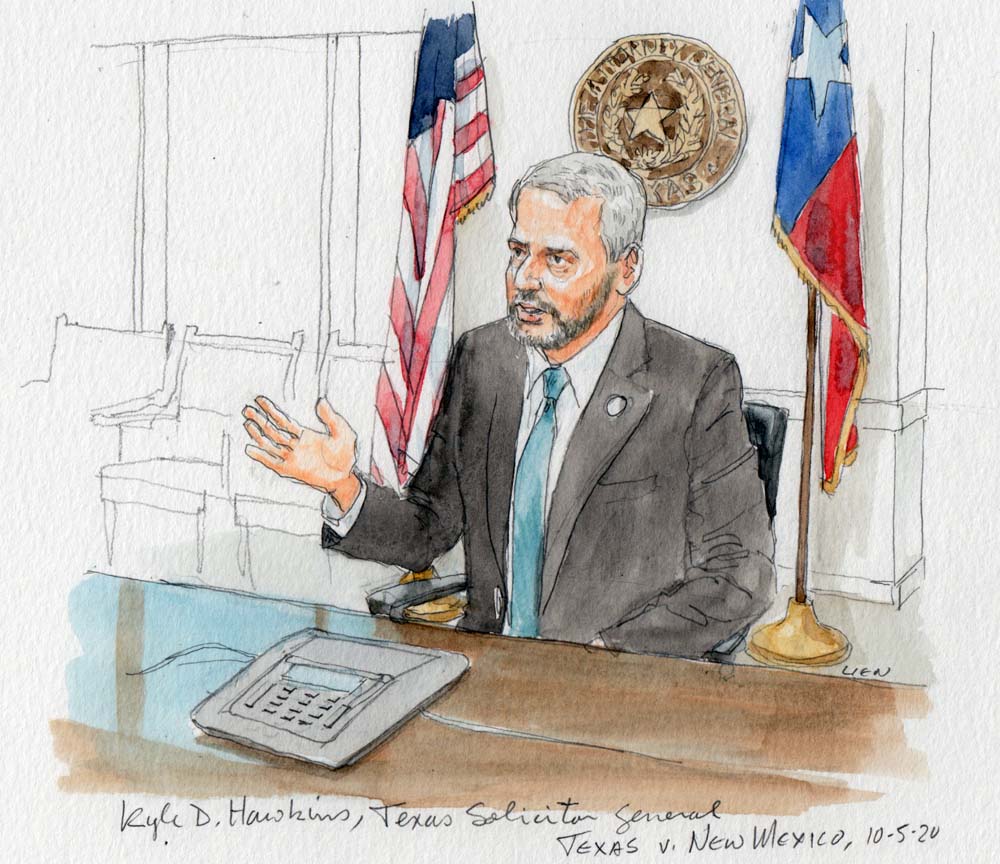Argument analysis: On first day of new term, Supreme Court seems skeptical of Texas’ arguments in interstate water dispute with New Mexico

on Oct 5, 2020 at 9:41 pm

On the opening day of its new term, an eight-member Supreme Court – with one vacancy following the death of Justice Ruth Bader Ginsburg – heard argument Monday in Texas v. New Mexico, a new dispute in a long-dormant Supreme Court case over the waters of the Pecos River. The Pecos River Compact, approved by Congress in 1949, apportions these waters between upstream New Mexico and downstream Texas. Legal and technical disputes over New Mexico’s obligations led to landmark Supreme Court decisions in the 1980s and a decree requiring New Mexico to increase its deliveries of water to the Texas state line. The court also appointed a “river master” to perform the calculations needed to determine New Mexico’s ongoing compliance.

Solicitor General Kyle D. Hawkins telephones in to argue for Texas (Art Lien)
The Pecos River master is one of only two such officials in the nation, appointed by the court to oversee one of its interstate water decrees. Only the Supreme Court can review a river master decision, but the court has never taken up a state’s challenge to such a decision until now. Thus, this latest round in Texas v. New Mexico is a first in the court’s interstate water jurisprudence dating back to the early days of the 20th century.
The current dispute originated with a tropical storm that dumped heavy rains on the Pecos Basin in September 2014. That water was stored in a federal reservoir, Brantley, located on the Pecos in New Mexico and operated by the U.S. Bureau of Reclamation. The bureau originally retained the high flows in Brantley for flood control purposes, but soon Texas asked that they be held in the reservoir and released later so that Texas could use them during the next irrigation season. Weather conditions in Texas did not cooperate, however, and in the end the bureau released the water the following summer at a time when Texas was unable to use it. During the months the water was held in Brantley, however, over 20,000 acre-feet of water evaporated. (An acre-foot is a measure of water volume, slightly less than one-third of a million gallons.)
After initially seeming close to an agreement on the accounting treatment of these losses, the two states reached an impasse, and the river master was forced to decide how to allocate them. He eventually decided that Texas should bear most of the evaporation losses, and all of them after March 1, 2015, when there was no longer a flood-control reason to keep the water in Brantley. He based this decision on a provision of the “River Master’s Manual,” which is incorporated by reference in the Supreme Court’s decree that resolved the earlier litigation. Texas challenged this determination, and the Court agreed to review it under a provision of the decree providing for such decisions to be reviewed under a “clearly erroneous” standard.
The argument before the court – which had originally been set for April but was postponed due to the coronavirus pandemic – was divided between Texas, New Mexico and the United States as amicus curiae. Like New Mexico, the United States had urged the court to deny review, and the federal government’s position on the merits was closely aligned with New Mexico’s.
Arguing for Texas, Kyle Hawkins urged the court to focus on the language of the Pecos River Compact itself. In Texas’ view, the compact addresses evaporation losses in only three circumstances, none of which applies here. The river master applied the manual in allocating the losses to Texas after finding that the water had been stored at Texas’ request, but Texas argued that the manual itself required different treatment. Texas also argued that the decree did not allow the master to give New Mexico a retroactive credit for the disputed evaporation losses. In essence, Texas’ position was a narrow legal one, arguing that the master’s actions violated the letter of the compact and decree.
On behalf of New Mexico, Jeff Wechsler argued that the river master’s decision was fully supported by the record and the law. New Mexico pointed to Texas’ November 2014 request to have the water held in Brantley until Texas could put it to use, and New Mexico’s response that all resulting evaporation losses must be borne by Texas. The river master’s procedure for deciding the issue had been accepted by all parties, so Texas could not complain that the decision was untimely. In New Mexico’s view, the river master has adequate authority and discretion to decide novel accounting issues, and he appropriately decided this one by applying the terms of the manual.
Arguing for the United States, Masha Hansford said the river master’s decision was “both technically accurate and entirely fair,” because Texas had requested that the water be stored for its use and because the manual clearly addresses the effect of such a request for allocating losses.
All eight justices asked questions of at least two of the attorneys, and their questioning suggested that most are skeptical of Texas’ position. The phrasing and tone of several questions – especially by Justices Stephen Breyer and Elena Kagan – indicated that the justices had a difficult time accepting Texas’ the-compact-is-all-that-counts arguments. Justice Neil Gorsuch at one point seemed to lose patience with Texas’ contentions, eventually interrupting Hawkins to say, “I got it.” None of the eight – with the possible exception of Justice Samuel Alito – seemed to find Texas’ position persuasive.
Although this case has little chance of setting important precedent because there are only two river masters (and the court is reluctant to appoint new ones), a couple lines of questioning suggest that the decision could prove interesting for interstate water lawyers. Two or three justices asked about different provisions of the compact than the River Master relied on for his decision, asking why they did not apply to the situation at hand. Thus, it is possible that the court may reach the same outcome as the river master, but base its decision on a compact interpretation different from his. In addition, more than one justice asked about the “clearly erroneous” standard of review, noting correctly that it does not apply to “special master” reports that the court regularly reviews in interstate water cases. It does apply to Pecos River master decisions, however, under the terms of the court’s own decree.
On the latter point, Hansford contended that the standard of review is not crucial because the river master’s decision was correct under any standard. Based on the questions posed in Monday’s argument, it seems very likely that the court will agree.


